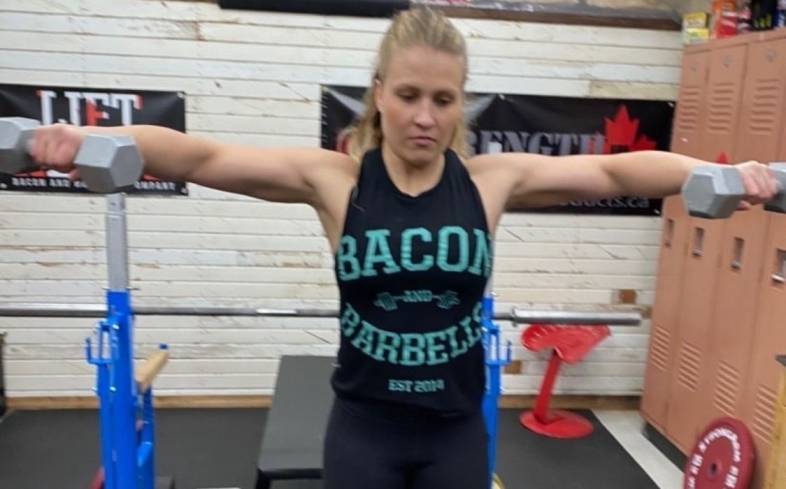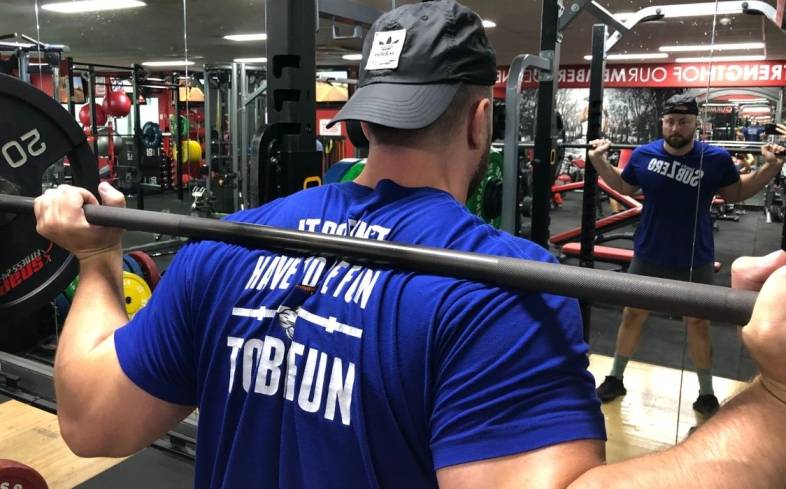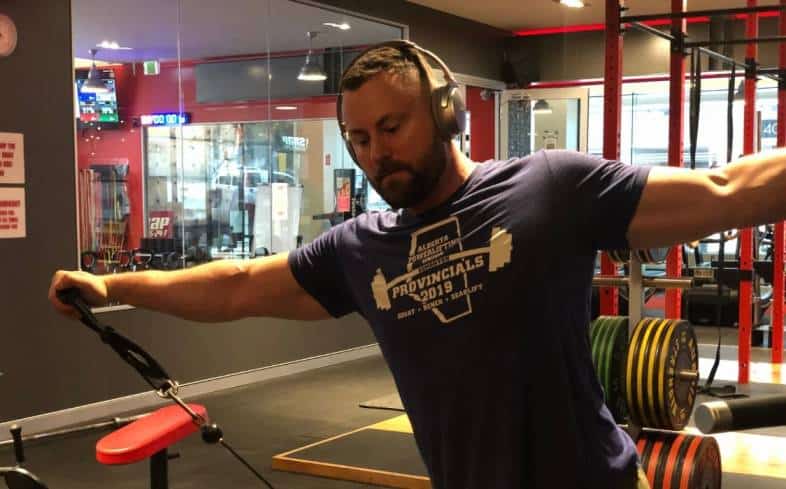Can You Do A Back And Shoulder Workout On The Same Day? (original) (raw)

Doing a back and shoulder workout is a common way to train these muscles quickly and effectively.
Combining different muscle groups within a training session allows you to train them more than once a week. Many people choose opposite muscles to be paired within the same workout, such as shoulders and back.
So, here's a common question: “Can I do back and shoulders on the same day?” Yes, you can train shoulders and back on the same day. Training shoulders and back is safe and effective and can increase strength and mass when programmed properly. When selecting shoulder and back exercises to target, you will need to consider your areas of weakness.
In this article, we will go through if back and shoulders are a good split, including what you need to know about training shoulders and back together on the same day, what you need to consider when doing so, and how to program back and shoulder exercises.
Read on to learn:
- Benefits of working back and shoulders together
- Things to consider when doing a back and shoulder workout
- How to program a back and shoulder workout
Table of Contents
Toggle
- Is Training Shoulders And Back On The Same Day Safe?
- Is Training Shoulders And Back On The Same Day Effective?
- Want to get advice on programming, technique, or competing? Speak with one of our coaches.
- 4 Benefits Of A Shoulder and Back Workout
- What Should You Take Into Consideration When Doing A Back And Shoulder Workout?
- 3 Ways To Program Your Back And Shoulder Workout
- Final Thoughts
- About The Author: Norman Cheung ASCC, British Powerlifting Team Coach
Is Training Shoulders And Back On The Same Day Safe?
Yes, training shoulders and back muscles on the same day is safe. There is not anything inherently dangerous with training these muscle groups together. There are bodybuilders, powerlifters, and Olympic weightlifters who train these muscle groups together.
One thing that is worth keeping in mind is that there is some crossover of certain smaller muscle groups with shoulder and back muscles, for example, the rear delts.
For these reasons, it is worth being careful, not over-training these muscle groups in the sessions just in case you risk injury like a strain.
Is Training Shoulders And Back On The Same Day Effective?
Yes, putting shoulders and back on the same day of training can be effective but the order you do it depends on what your training goals are. If your training goals are for building muscle, then it does not matter too much how you organize the exercises. If you are training for muscular strength, it do matter when you train certain exercises.
Research suggests that exercise order regardless of whether it is a multi-joint or single-joint exercise does not matter too much as scenarios produce similar gains. However, for maximal strength, the exercises performed earlier in the session elicit better gains.
So if you want to prioritize shoulder strength, perform the shoulder exercises first. If you want to prioritize back strength, perform the back exercises first.
What training shoulders and back on the same day also allows you to do is train these muscle groups more than once a week, which research has suggested may be superior for muscle gain.

Want to get advice on programming, technique, or competing? Speak with one of our coaches.
4 Benefits Of A Shoulder and Back Workout

Here are the 4 benefits of training shoulders and back together:
- It can be more time-efficient to train
- It enables you to train muscle groups at least twice a week
- It allows for exercises that hit both muscle groups
- It improves work capacity
It Can Be More Time-efficient to Train
When you train two separate and unrelated muscle groups together, you can use a training technique called supersetting.
Supersetting two exercises together means you intertwine the sets of the exercises together i.e. after you perform a set for one exercise, the performance of a set for the other exercise immediately follows it.
So you can essentially superset back and shoulder exercises together.
This can be a much more time-efficient way of training. There are no rest periods between the superset, but some people choose not to have any rest at all after a cycle of a superset. Traditionally, people would normally have a 1 to 3-minute rest between a superset.
It Enables You to Train Muscle Groups at Least Twice a Week
As you choose to train two different muscle groups together, you remove the need to perform the 2nd muscle group on another day. This means that you can perform these two muscle groups at least twice a week.
Research suggests that to build muscle mass, train muscle groups twice a week may be more superior to training muscle groups once a week.
For the purpose of maximal muscular strength, it seems like training muscle groups twice a week or more seems to be better if increasing the training frequency allows you to do more work on the muscle.
It Allows for Exercises That Hit Both Muscle Groups
Back and shoulder exercises are generally very different movements. However, because of the proximity that these muscle groups have with each other, certain smaller muscle groups overlap. There are exercises that overlap both back and shoulder muscles.
Muscles such as the rear delt muscles and the upper traps are examples. Here are some examples of exercises that target both back and shoulder muscles:
- Rear delt fly
- Lateral raise
- Face pulls
- Upright rows
It Improves Work Capacity
When you train two separate muscle groups, you can choose to use supersets. One major advantage with supersets is that there is not much downtime when it comes to resting after one set because you get right back into another exercise for a different muscle group.
Whilst you are switching to train a second muscle group, you are still challenging your energy systems as well through doing this. You improve your anaerobic endurance fitness levels by doing this.
Over time, you will improve your work capacity for activities that involve high-intensity bursts of action, such as sprinting, lifting weights, sports that have intermittent bursts of activity such as badminton.
Wondering if you can train back and chest on the same day? Check our other article where we discuss the benefits and how to do it properly.
What Should You Take Into Consideration When Doing A Back And Shoulder Workout?

When choosing to work out both shoulders and back on the same day, there are a few things you need to take into consideration when programming it in.
Here are some things to be taken into consideration:
You Should Consider Where Your Weaknesses Are
If your shoulders are a weakness or you have not trained them as much in the past, you may consider training them earlier in the session.
Similarly, if your back muscles are weak, then put them earlier on in the session.
What Equipment You Have Access To
You need to consider what training stations and equipment you have access to in order even to consider what exercises you want to put together if you are doing supersets.
You need to think about what is available and the proximity of the equipment, especially if they are machines. When you superset two exercises together, you want to minimize rest time between the two exercises.
How Long Do You Have To Train
Depending on how long you have to train can determine whether you do different things in a workout session.
If you have longer to train, you may decide not to do supersets and instead spread exercises out as traditional straight sets. You may choose to do more isolation exercises instead of being more efficient by choosing compound exercises.
How Often You Can Train
If you can train more often, it may be better for your back and shoulder muscles if you work them out more than once a week.
Most people do not need to work out those muscle groups at least twice a week.
If you're a powerlifter, check out our article on How Do Powerlifters Train Shoulders?
3 Ways To Program Your Back And Shoulder Workout

Here are 3 ways to structure your back and shoulder workouts:
- Weak Shoulders – Train Shoulders First
- Weak Back – Train Back First
- Balanced Shoulders/Back – Alternate Between Muscle Groups
Weak Shoulders – Train Shoulders First
Shoulder Exercises supersetted with Back Exercises.
Day 1
- Overhead Press superset Barbell Row – 3 sets 8 reps
- Dumbbell Shoulder Press superset Dumbbell Row – 3 sets 10 reps
- Dumbbell Lateral Raise – 2 sets 15 reps
- Machine Rear Delt Fly – 2 sets 15 reps
Ever wonder if overhead press helps increase bench press strength? We answer that question in our other article.
Day 2
- Seated Arnold Press superset Chest Supported DB Row – 3 sets 8 reps
- Dumbbell Front Raise superset Underhand Lat Pulldown – 3 sets 10 reps
- Cable Lateral Raise – 2 sets 15 reps
- Face Pulls – 2 sets 15 reps
Weak Back – Train Back First
Back Exercises supersetted with Shoulder Exercises.
For more information, check out our article on how powerlifters train back.
Day 1
- Barbell Row superset Seated Dumbbell Shoulder Press – 3 sets 8 reps
- Dumbbell Row superset Seated Lateral Raise – 3 sets 10 reps
- Dumbbell Pullover – 2 sets 15 reps
- Bent-Over Dumbbell Flys – 2 sets 15 reps
Day 2
- T Bar Row superset Overhead Press – 3 sets 8 reps
- Lat Pulldown superset Cable Lateral Raise – 3 sets 10 reps
- Cable Pullover – 2 sets 15 reps
- Single Arm Rear Delt Fly – 2 sets 15 reps
Check out my article on the Best Reverse Pec Deck Alternatives.
Balanced Shoulders/Back – Alternate Between Muscle Groups
Day 1 Shoulder Exercises supersetted with Back Exercises.
Day 2 Back Exercises supersetted with Shoulder Exercises.
Day 1
- Overhead Press superset Barbell Row – 3 sets 8 reps
- Dumbbell Shoulder Press superset Dumbbell Row – 3 sets 10 reps
- Dumbbell Lateral Raise – 2 sets 15 reps
- Machine Rear Delt Fly – 2 sets 15 reps
Can't do overheard press? Check out our article on the 9 Best Overhead Press Alternatives.
Day 2
- T Bar Row superset Overhead Press – 3 sets 8 reps
- Lat Pulldown superset Cable Lateral Raise – 3 sets 10 reps
- Cable Pullover – 2 sets 15 reps
- Single Arm Rear Delt Fly – 2 sets 15 reps
Don't have access to a T-bar Row? Check out my other article on the Best T-Bar Row Alternatives.
Final Thoughts
The right back and shoulder workout can be a pillar of your weekly training. Training shoulders and back together is a possible combination of muscle groups that you can train together.
The only thing you really need to think about is the fact that muscles like the rear delts get overlapped with both shoulder and back exercises, and also think about how one exercise might affect the other.
For example, if you do barbell rows before the overhead press, make sure not to fatigue your back so much that you cannot hold your posture for the overhead press.
Related Articles:
- What Else Should I Do On Shoulder Day? (4 Examples)
- 18 Rear Delt Workouts (Barbell, Dumbbell, Cable, Machine)
- 3 Cable Shoulder Workouts For Mass (Complete Guide)
- Can You Train Shoulders And Biceps On The Same Day?
- Can You Train Back And Legs On The Same Day?
- Can You Train Legs and Shoulders on the Same Day?
- Can You Train Chest And Legs On The Same Day?
- Can You Train Legs And Arms On The Same Day?
- Can You Train Biceps And Chest On The Same Day?
About The Author: Norman Cheung ASCC, British Powerlifting Team Coach

Norman Cheung
Norman Cheung is a powerlifting coach and an accredited strength and conditioning coach under the UKSCA. He has been coaching powerlifting since 2012 and has been an IPF Team GB coach since 2016. He has experience with coaching a variety of lifters from novices to international medallists and international university teams. Along side coaching, he takes interest in helping powerlifters take their first step into coaching. He currently runs his coaching services at strongambitionscoaching.com